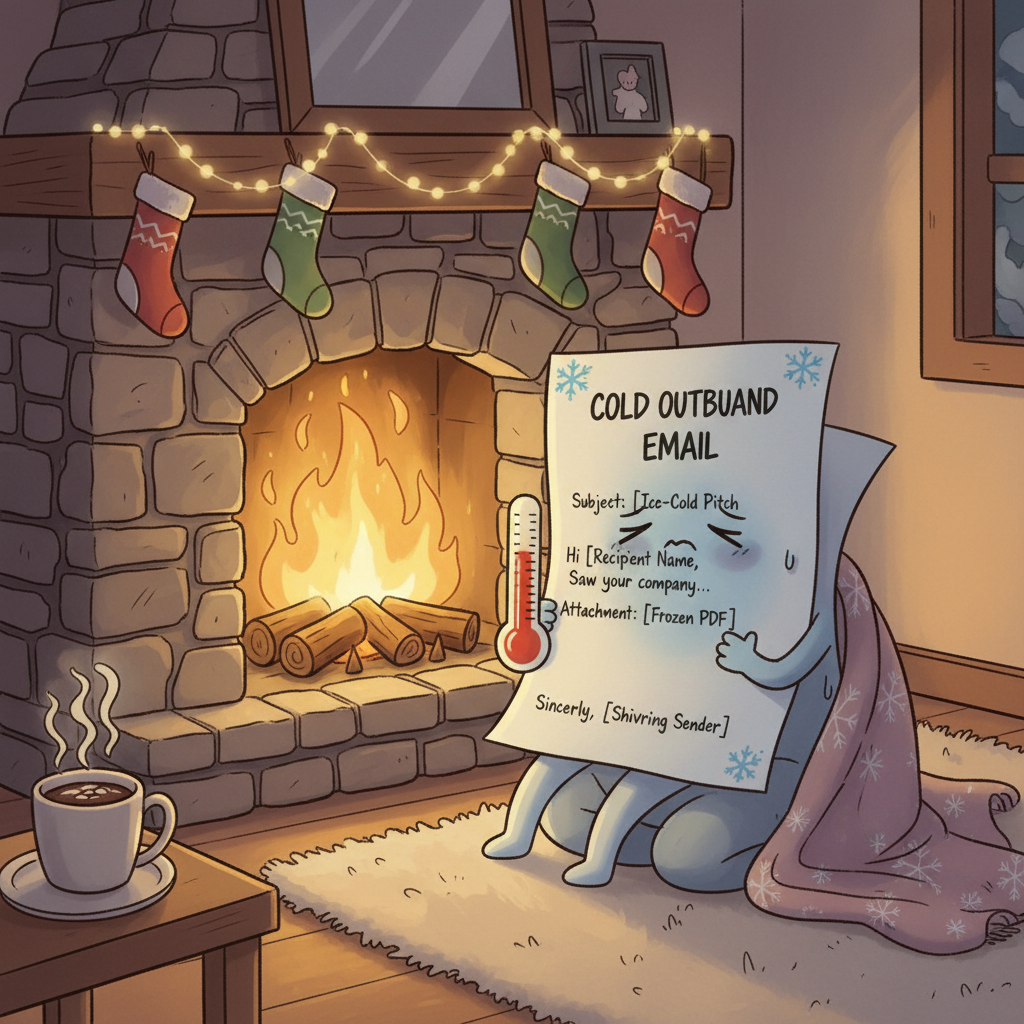
You spent 20 minutes crafting the perfect cold email. You hit send. Then... crickets.
Sound familiar? You're not alone. The average cold email reply rate hovers around 1-8%, and most land in the digital graveyard we call the spam folder. But here's the thing: some cold emails consistently get 20-30% response rates. What's their secret?
After analysing thousands of successful cold emails and compiling the latest 2025 data, we've identified exactly what separates emails that convert from those that get deleted in 0.3 seconds. Spoiler: it's not about being clever or pushy—it's about being human, brief, and genuinely helpful.
Let's dive into what actually works (and what kills your response rates).
The Golden Rule: Keep It Brutally Short
Here's a stat that should change how you write emails forever: emails around 54 words get the highest reply rates. Not 100 words. Not 200. Fifty-four.
Why? Because your prospect is scanning their inbox at a red light, between meetings, or while their coffee brews. They'll give you 10-15 seconds maximum. If your email requires scrolling on mobile, you've already lost.
What this looks like in practice:
- 2-3 short paragraphs total
- Each paragraph = 1-2 sentences
- Zero fluff or filler words
- Scannable in under 15 seconds
The data is clear: emails over 100 words see reply rates drop sharply. Every extra sentence is a chance for your prospect to lose interest and move on.
Subject Lines: 1-5 Words Max
Your subject line has one job: get the email opened. In 2025, that means brevity and clarity over cleverness.
The winning formula:
- 1-5 words maximum
- Clear and relevant (no vague "Quick question")
- Mobile-friendly (displays fully on small screens)
- Zero gimmicks
What NOT to do:
- ❌ "Re: Following up" (fake reply chains)
- ❌ "FREE DEMO - ACT NOW!!!" (spam city)
- ❌ All caps or excessive punctuation
- ❌ Trigger words like "guarantee," "exclusive offer," "limited time"
What works:
- ✅ "Question about [their company]"
- ✅ "[Specific pain point] solution"
- ✅ "Thoughts on [relevant topic]?"
Your subject line should create just enough curiosity to earn the open, nothing more.
Personalisation: Beyond First Names
Listen, we can all tell when an email is mass-blasted with our name swapped in. In 2025, generic templates have response rates in the low single digits—because everyone can spot them a mile away.
Real personalisation means:
Reference something specific about them or their company:
- A recent LinkedIn post they shared
- A company milestone or announcement
- An industry challenge they're facing
- A mutual connection or shared interest
Compare these openings:
Generic (doesn't work): "Hi Sarah, I'm reaching out to introduce our amazing marketing automation platform that helps companies like yours..."
Personalised (works): "Hi Sarah, saw your post about struggling with email deliverability after your team scaled to 5 sales reps. We solved this exact issue for [Similar Company]..."
The second email proves you're not sending the same message to 1,000 people. It shows you've done your homework and have something relevant to say.
Lead With Value, Not Your Company Bio
Nobody cares about your company's founding story, your "industry-leading solutions," or how many awards you've won. At least not yet.
Your prospect has one question: "What's in it for me?"
Answer that in the first 1-2 sentences.
The value proposition formula:
- Identify their specific problem
- Share how you solve it
- Prove it with brief social proof
Example:
"Managing wholesale orders across 3+ platforms is eating up 10+ hours of your team's time each week. Our tool consolidates everything into one dashboard—we helped [Similar Company] cut their order processing time by 70%."
Notice what's missing? A paragraph about "We are a leading innovator with 15 years of experience..." Save that for later. Lead with the problem you solve and the outcome they'll get.
One Simple Call-to-Action
Here's where most cold emails die: they ask for too much, too fast.
Requesting a 30-minute demo call in your first email? That's a big commitment from a stranger. Asking them to visit your website, read a case study, AND book a meeting? That's three decisions they won't make.
The 2025 approach: Make it easy to say yes.
High-friction CTAs (avoid):
- "Can we schedule a 30-minute demo next week?"
- "Visit our website, check out our features, and let me know what you think"
- "Here's my calendar—pick a time that works"
Low-friction CTAs (use these):
- "Worth exploring further?"
- "Would you be open to a brief 10-minute chat?"
- "Is this something that aligns with your goals this quarter?"
One CTA. One question. Make it conversational and easy to respond to with a simple "yes" or "no."
Your goal isn't to close a deal—it's to start a conversation.
Write Like a Human (Because You Are One)
The cold emails that get responses sound like one person writing to another—not a marketing department writing to a database.
Conversational tone checklist:
- Use "Hi [Name]" not "Dear Sir or Madam"
- Write like you speak (contractions are fine)
- Avoid corporate jargon and buzzwords
- Keep sentences simple and clear
- Proofread, but don't stress about being perfect
Compare:
Too formal: "Dear Mr. Johnson, I am writing to inquire whether your organization would be amenable to exploring a strategic partnership..."
Just right: "Hi Mike, I noticed your team is expanding into the UK market. We've helped similar companies navigate that exact growth phase—would you be open to a quick chat about what worked?"
The second email feels like it came from a real person, not a template. That's the tone you're after.
Format for Scanning, Not Reading
Your prospect isn't reading your email word-for-word. They're scanning it.
Make it scannable:
- Use line breaks between thoughts
- Keep paragraphs to 1-2 sentences max
- Consider one or two bold words for emphasis (but don't overdo it)
- Follow a clear flow: Greeting → Personal intro → Value prop → CTA → Sign-off
Optional but effective: Add a P.S. line with a personal touch. Reference something from their LinkedIn, congratulate them on a recent win, or mention a shared interest. This humanizes you and can boost replies.
Example P.S.: "P.S. Loved your recent post about remote team culture—our team just went through a similar transition!"
Keep Your Signature Simple
Your email signature matters more than you think—especially for deliverability.
Best practice:
- Plain text (no HTML or images)
- Name, title, company
- One link maximum (website or LinkedIn)
- Simple sign-off like "Best regards"
Avoid:
- Multiple logos or social media icons
- Image-heavy signatures
- Several links
Heavy signatures trigger spam filters. Keep it minimal and professional.
Timing and Follow-Ups Matter
When to send: The data shows Tuesday and Thursday mornings (8-10am) get the best open and reply rates. Recipients are active but not drowning in Monday chaos or Friday wind-down.
The follow-up strategy: Don't give up after one email. Most deals happen on follow-ups, but most people never send them.
Effective follow-up cadence:
- First email → Day 0
- First follow-up → Day 5-7
- Second follow-up → Day 12-14
- Final follow-up → Day 19-21
The key: Each follow-up should add new value, not just "checking in." Share a relevant resource, offer a different angle, or provide new insights. Never just resend the same email.
What Kills Cold Emails: Mistakes to Avoid
1. Walls of Text
If your email scrolls more than once on mobile, it's too long. Period. Emails beyond 100-200 words see reply rates plummet. Nobody is reading your six-paragraph unsolicited pitch.
2. Generic Templates
"To whom it may concern" and "I'm reaching out to introduce our services" = instant delete. If your email could be sent to anyone, it will resonate with no one.
3. Spammy Language
Avoid these like the plague:
- "FREE $$$!!!"
- "Act now! Limited time!"
- "100% guarantee"
- "Exclusive offer"
These trigger spam filters and make you look unprofessional.
4. Multiple Links or Attachments
More than one link in your email raises your spam score. Attachments in cold emails? Absolutely not. They look suspicious, won't get opened, and hurt deliverability.
Rule: One link maximum (usually in your signature).
5. Hard Selling Too Fast
Your first email shouldn't include pricing, detailed features, or a demand to "book a demo now." That's too much pressure. Warm them up first.
6. Too Formal or Too Casual
"Dear Sir or Madam" feels like a form letter. "Hey buddy!" to a C-level executive is inappropriate. Find the middle ground: professional but friendly.
7. Ignoring Mobile
Over 60% of emails are opened on mobile devices. If your email doesn't look good on a phone screen, you're losing more than half your audience.
Your Cold Email Checklist
Before you hit send, run through this:
Subject Line:
- 1-5 words maximum
- No spam triggers or gimmicks
- Clear and relevant
Email Body:
- Under 100 words total
- Includes specific personalisation
- Focuses on their needs, not your company
- Has clear value proposition
- Contains only ONE call-to-action
- Uses conversational tone
- Formatted with short paragraphs and line breaks
Technical:
- Plain text or minimal HTML
- Simple signature with max one link
- No attachments
- Proofread for typos
The Bottom Line
Cold emailing in 2025 isn't about tricks or hacks. It's about respecting your prospect's time, offering genuine value, and sounding like a real human being.
The emails that work are:
- Short (around 50-70 words)
- Personal (specific to the recipient)
- Valuable (solving their problem, not pitching your company)
- Conversational (human, not corporate)
- Easy to respond to (one low-friction CTA)
The emails that fail are the opposite: long, generic, self-serving, formal, and demanding.
Remember, your goal isn't to close a deal in the first email—it's to start a conversation. Keep it brief, make it about them, and make it easy to say yes.
Now go write an email that actually gets opened.


